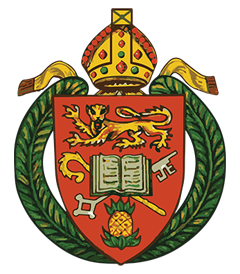 Baptism is the sacrament by which God unites us with Christ, adopts us as His children, and makes us members of Christ’s Body, the Church, and inheritors of the Kingdom of God.
Baptism is the sacrament by which God unites us with Christ, adopts us as His children, and makes us members of Christ’s Body, the Church, and inheritors of the Kingdom of God.
– (Book of Common Prayer CPWI pg. 409)
Background
The word “baptism” is derived from a Greek verb that means “to dip,” “to wash,” or “to plunge.” It should, therefore, come as no surprise that the outward sign of the sacrament of baptism is the cleansing or bathing of the candidate with water.
Christians were, however, not the first people to use baptismal rites. There is clear evidence of such practices being part of the pre-Christian Jewish community of faith.
Washing has become the primary symbol in Christian understanding of baptism. However the metaphor of washing is only one feature of a much richer set of images.
• The Foundation of Sacramental Theology
The prophets used symbolic acts and objects for encountering God, as portrayed in the Old Testament. In so doing, a fundamental principle in Christian understanding of the sacraments (sacramental theology) is the fact that the material can affect the spiritual. As the Jewish circumcision is seen to place Jewish males within the covenant relationship between Israel and God, the early Christian community came to understand that an act in the physical and material order (baptism) leads to initiation/membership in the covenant community of faith (the Church).
The Jewish community in the pre-Christian period used ritual washings as a regular feature. The act of outward washing with water signified an inner reality of the cleansing of the soul from ritual or moral offences. One such use of ritual washing was for the reception/admission of non-Jew converts (proselytes) into the religion of Israel.
The religion of Israel influenced the Christian practice and understanding of baptism in other ways. For example, in St. Paul’s famous statement about baptism as a participation in the death and resurrection of Jesus Christ, he may have been recalling the image in Genesis 1:2 which mentions ‘the Spirit of God moving over the face of the waters’ in the beginning of creation, and making a connection between this movement of water and the beginning of creation. For Paul then, he could assert that the believer in Christ, when baptized, dies with Christ (to the old order) and rises to a new creation.
• Baptism in the New Testament
The earliest evidence of the practice of baptism in the New Testament are the baptisms done by John the Baptist, and these must be understood as pre-Christian practices. The same is true of the baptisms attributed to the disciples of Jesus. The reason for this understanding is well articulated by St. Paul who sees a participation in the death and resurrection of Jesus as the core to an understanding of Christian baptism, and this could only have taken place after the crucifixion and resurrection of Jesus.
• The Baptism of John
John challenged his hearers to respond by way of ‘a baptism of repentance for the forgiveness of sins’ in view of what he saw as an approaching judgement. John’s baptism has, therefore, been characterized as “a baptism of repentance and a baptism of eschatological expectation.” It had both ethical and eschatological/anticipatory dimensions relating to the final judgement and the end of the world.
• The Baptism of Jesus by John the Baptist
With the baptism of Jesus by John, however, Jesus not only gave validation and authority to baptism, but there is also a further movement as his water baptism becomes a baptism of the Spirit. So Christian baptism, while including the baptism for the forgiveness of sins would go beyond this to become a baptism of the Spirit. Christian baptism in comparison to that of John’s may be regarded as having deeper and more positive dimensions. However, Christian baptism does not become a reality until we get to the birth of the church, following the death, resurrection and ascension of Jesus.
• Baptism and the Day of Pentecost
It has been suggested that the coming of the Holy Spirit on the day of Pentecost be regarded as baptism with the Holy Spirit and as the first Christian baptism. While it appears that some of the converts here receive the Holy Spirit before they are baptized, yet Peter in his preaching called upon his hearers to ‘Repent, and be baptized everyone of you in the name of Jesus Christ for the forgiveness of your sins, and you shall receive the gift of the Holy Spirit’ (Acts 2:38). It is difficult to establish a distinction between ‘water baptism’ and ‘spirit baptism’ from the events of the Day of Pentecost. What seems clear, however, from a serious reading of the text is that the two dimensions were brought together on the same occasion in the life of the Church, thus bringing into a dynamic relationship the outward and inward dimensions of baptism.
• Baptism in Acts of the Apostles and New Testament Times
There are varying patterns of baptism in New Testament times, as seen in the Acts of the Apostles, and these continued into the first century. This raises the question of the formula to be used in baptism and the fact that the gift of the Holy Spirit seems to be bestowed sometimes, before, and sometimes, after the baptism.
• The Incarnation and Baptism
TheIncarnationbecomesanothercentralpointofreferenceforanunderstandingofbaptism.St.John’sPrologue(John1:1-18)providesthemostprofoundinsightintotheIncarnationandwhatitmeansforhumanity.
Images of union, inwardness and relationship become central to this treatment of the Incarnation – “in him was life,” “the law indeed was given through Moses; grace and truth came through Jesus Christ,” and “to all who received him…he gave power to become children of God.”
This reference to“receive him” does not only point to reception, but thegift of “power.” In a similar way, the “truth” which comes through Christ refers to the reality of God, and Christ imparting something of the divine to humanity.
Further on, in John 3:16, the promise is of “eternal life”, the gift of a qualitative life. Preceding this saying of Jesus is the dialogue between Jesus and Nicodemus on the issue of re-birth. Jesus’ response picks up the notion of union through the communication/imparting of the divine to humanity through him as he says to Nicodemus, “What is born of the flesh is flesh, and what is born of the Spirit is spirit.” Spirit, then, is not definitive of the nature of “man” but is given as a gift through Christ.
• The Holy Spirit and Baptism
The promise of the Holy Spirit, the Paraclete, the Comforter, to which our Lord pointed, was to be the means by which the risen Christ is communicated to the disciples. So it becomes another expression of the metaphor of union and inwardness by which the one who is in Christ receives the Christ life. This life-giving nature of the Holy Spirit is underscored by our Lord in John 7:37-39 with the promise of “living water”, after he was glorified. The Holy Spirit then becomes understood as an indwelling presence making possible union with the risen Christ. In Acts 19, Paul encounters some disciples who had received the baptism of John but had not heard of the Holy Spirit or received the Holy Spirit. Here Paul’s question becomes important – “Into what then were you baptized?” This question moves towards an affirmation of baptism as a sacrament which makes possible “union” with Christ and, as a consequence, the reception of the Holy Spirit with power.
• Water Baptism and the Outpouring of the Spirit
In Acts 2:38, repentance, baptism, the forgiveness of sins, and the gift of the Holy Spirit are all brought into a relationship. In other passages such as Acts 10:47, Acts 8:17, and Acts 19:6 the sequence in which baptism is administered and the Holy Spirit received is not consistent. What is clear from these incidents, however, is that “the Holy Spirit and baptism are directly and intimately related, and the laying on of hands or sealing (anointing) (2 Corinthians 1:22; Ephesians 1:13 and 4:30), seems to testify to this relation by emphasizing the presence of the Spirit in those baptized.”
• The Trinitarian Formula
The Commission of Jesus is for his disciples to baptize “in the name of the Father and of the Son and of the Holy Spirit.” (Matthew 28:19). The earliest documentation for the early Church speaks clearly to the use of a Trinitarian formula for baptism – “And concerning baptism, baptize in the name of the Father and of the Son and of the Holy Spirit.”
• Immersion and Affusion
The earliest Christian manual which dates back to the first century, the Didache, also speaks to the provision for baptism to be administered in running water and by pouring water three times over the head of the candidate, that is, baptism by affusion, rather than by the more popular practice of the day, immersion. It seems clear that the baptism being practiced at this time was primarily for adult converts.
• Baptism of Infants
Giventhefactthattheearliestconvertstothefaithwereadults,theNewTestamentaccountsdonotprovideconclusiveevidencefororagainstthebaptismofinfants(paedobaptism)althoughthepracticewaspresentinthechurchfromasfarbackasNewTestamenttimes.
Themostpopularargumentadvancedbythosewhosupportinfantbaptismisthat,inthosepassageswhichspeakofhouseholdsbeingbaptized,(Acts16:15,33;18:8;1Corinthians1:16)childrenandslavesofthefamilywouldhavebeenincluded.
Those opposed to the baptism of infants cite the demands of repentance and faith as a precondition for persons to be baptized (Mark 16:16; Acts 2:38); and, therefore, conclude that the baptism of infants is not possible.
Solid historical evidence of the baptism of infants in the Church is found in the third century document the Apostolic Tradition which makes it clear that those prepared for baptism – the catechumens – are people of all ages. The document includes the instruction that children are to be baptized first. The oldest book of Christian liturgy, the Gelasian Sacramentary, which dates back to the sixth to eighth centuries, also states that, by that time, the persons to be baptized were mainly small children or babies. It further notes that the Trinitarian formula should be used, and thus, water was to be poured “thrice upon the candidate’s head in the name of the Father, Son, and Holy Spirit.”
• New Testament Metaphors of Initiation
In addition to the liturgical and historical development of Christian initiation, there are several New Testament metaphors of initiation. Among these metaphors are:
UnionwithJesusChrist(Romans6:3-5,
Colossians 2:12);
Incorporationintothechurch
(1 Corinthians 12:13);
New birth(John3:5,2Corinthians5:17,
2Corinthians5:18-19);
Forgiveness of sin (Acts 22:16, 1 Corinthians 6:11);
Reception of the Holy Spirit (Acts 19:1-7).
• The Baptismal Covenant
The Baptismal Covenant is the solemn promise, or sacred agreement, in which God, the principal actor, adopts human persons as his children, and makes them members of Christ’s Body, the Church, and inheritors of the Kingdom of God. This is the good news of the gospel, and our reception of this grace of God, to which we give our assent by baptism, and which we renew from time to time, calls us to live a life in which we seek to become all that we, or our parents and godparents promised at our baptism – children of God.
”In Baptism we became members of Christ, children of the Heavenly Father, inheritors together of the Kingdom. This was the work of God who adopted us as His children and made us members of the family of God.” (The Book of Common Prayer CPWI page 284)
